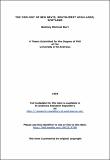Files in this item
The geology of Ben Nevis, South-west Highlands, Scotland
Item metadata
| dc.contributor.advisor | Brown, P. E. (Peter E.) | |
| dc.contributor.advisor | Stephens, W. E. | |
| dc.contributor.advisor | Rogers, Graeme | |
| dc.contributor.author | Burt, Rodney Michael | |
| dc.coverage.spatial | 483 | en_US |
| dc.date.accessioned | 2016-11-04T11:53:38Z | |
| dc.date.available | 2016-11-04T11:53:38Z | |
| dc.date.issued | 1994 | |
| dc.identifier | uk.bl.ethos.640158 | |
| dc.identifier.uri | https://hdl.handle.net/10023/9766 | |
| dc.description.abstract | The Ben Nevis volcanic-plutonic Complex was intruded into garnet grade Precambrian metasediments in the Southwest Highlands of Scotland towards the end of the Caledonian Orogeny. A variety of techniques have been applied to the Ben Nevis Complex in order to model its volcanic and plutonic evolution; these include: field mapping, petrography, mineral chemistry, whole rock major and trace element geochemistry and a combined study of the isotopes of neodymium and strontium. Rocks of the volcanic pile are subdivided into the following formations; the Allt a' Mhuillin formation, the Coire na Ciste formation, the Ledge Route formation and the Summit formation, and these overlie a basement of Dalradian schist. Fine grained metasediments of the Allt a' Mhuillin formation were deposited in a lacustrine basin into which entered a series of non-volcanic mass flow units. Non-volcanic deposition was terminated with the entry of the first volcaniclastic lahars of the Coire na Ciste formation into the Ben Nevis basin. Block and ash flows, lava flows and sills are also found in this formation. The Ledge Route formation testifies to a complex period of quiescence, airfall deposition and mass flow movement after which localised flows of lava dominate the overlying Summit formation. A single felsite dyke is found intruding the volcanic pile and is correlated with early members of the Ben Nevis dyke swarm in the northern area of the Ben Nevis Complex. Plutonic rocks of the Ben Nevis Complex are subdivided into the Fine Quartz Diorite, Sgurr Finnisg-aig Quartz Diorite, Coarse Quartz Diorite, Porphyritic Outer Granite and Inner Granite; these were intruded to a high level in the crust. A dextral stress regime operated during the intrusion of the plutonic rocks. Each of the above units was intruded as a series of pulses. Mass balance and qualitative trace element vector modelling (Rayleigh crystallisation) is able to model the geochemical evolution of the Porphyritic Outer Granite using plagioclase, amphibole, biotite and magnetite as the fractionating assemblage. Pyroxene is found as a phenocryst and as a groundmass phase in the quartz diorites with calcic amphibole found mainly as a replacement mineral after pyroxene; however, trace element modelling identifies amphibole as a fractionating phase. Isotopic modelling of the Ben Nevis Complex indicates the involvement of at least three components; these being a mantle source, a lower crustal source with similar isotopic characteristics to the Islay-Colonsay-Basement and, of lesser importance, Dalradian metasediments. No single parental magma can explain the geochemical and isotopic variation of the Ben Nevis Complex. | en_US |
| dc.language.iso | en | en_US |
| dc.publisher | University of St Andrews | |
| dc.subject.lcc | QE264.N3B8 | |
| dc.subject.lcsh | Geology--Scotland--Ben Nevis | en_US |
| dc.subject.lcsh | Scotland--Ben Nevis | en_US |
| dc.title | The geology of Ben Nevis, South-west Highlands, Scotland | en_US |
| dc.type | Thesis | en_US |
| dc.type.qualificationlevel | Doctoral | en_US |
| dc.type.qualificationname | PhD Doctor of Philosophy | en_US |
| dc.publisher.institution | The University of St Andrews | en_US |
This item appears in the following Collection(s)
Items in the St Andrews Research Repository are protected by copyright, with all rights reserved, unless otherwise indicated.

